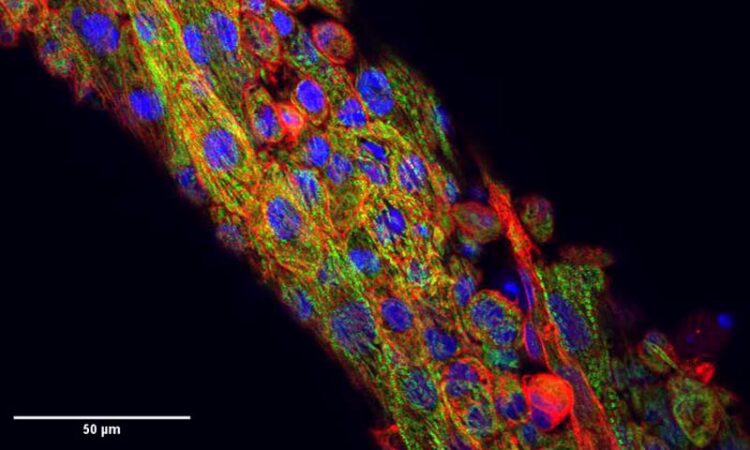Virtual drug quiets noise in heart tissue images

This image shows the microtissues from Nate Huebsch’s lab that are stained for cell nuclei (blue), sarcomeric alpha-actinic (red) and Myosin Binding Protein C (MYBPC3; green). Mutations in MYBPC3 cause hypertrophic cardiomyopathy. These sarcomere structures are disrupted by chemical blebbistatin.
Credit: Huebsch lab, Washington University in St. Louis
Researchers at Washington University in St. Louis have developed a new computational approach to removing movement in images of expanding and contracting heart cells and tissues. By computationally removing movement, the algorithm mimics a drug’s action in stopping the heart, without compromising cellular structure or tissue contractility.
Results of the research, led by Nathaniel Huebsch, an assistant professor of biomedical engineering, and Guy Genin, the Harold and Kathleen Faught Professor of Mechanical Engineering, both at the McKelvey School of Engineering, are published in the Sept. 11 Proceedings of the National Academy of Sciences.
“When the heart beats, the electrical signal goes through the tissue, and that triggers mechanical squeezing,” said Huebsch, who studies how mechanical cues affect heart development and disease. “In many cases, deadly arrhythmias happen because the electric pulse becomes decoupled from the mechanical squeezing. Our group leverages biomaterials and genetics to study how inherited cardiomyopathies develop, and we are very excited to have a tool that allows us, for the first time, to directly and non-invasively study electro-mechanical coupling in cardiomyocytes.”
The team’s algorithm mimics the action of blebbistatin, a drug that inhibits motion of heart muscle but also can negatively impact the underlying structure of these cells.
This so-called virtual blebbistatin was created from two algorithms: one that has been successful in estimating displacements for cardiac mapping; and another that uses the first to map evolving signals back to a stabilized image of the tissue. The approach allows researchers to directly monitor the coupling of calcium waves, membrane voltage and mechanical contraction beat by beat in heart tissue models, giving insight into diseases of the heart.
Read more on the McKelvey School of Engineering website.
Journal: Proceedings of the National Academy of Sciences
DOI: 10.1073/pnas.2212949120
Article Title: Virtual blebbistatin: A robust and rapid software approach to motion artifact removal in optical mapping of cardiomyocytes
Article Publication Date: 15-Sep-2023
Media Contact
Talia Ogliore
Washington University in St. Louis
talia.ogliore@wustl.edu
Office: 314-935-2919
All latest news from the category: Medical Engineering
The development of medical equipment, products and technical procedures is characterized by high research and development costs in a variety of fields related to the study of human medicine.
innovations-report provides informative and stimulating reports and articles on topics ranging from imaging processes, cell and tissue techniques, optical techniques, implants, orthopedic aids, clinical and medical office equipment, dialysis systems and x-ray/radiation monitoring devices to endoscopy, ultrasound, surgical techniques, and dental materials.
Newest articles

Innovative 3D printed scaffolds offer new hope for bone healing
Researchers at the Institute for Bioengineering of Catalonia have developed novel 3D printed PLA-CaP scaffolds that promote blood vessel formation, ensuring better healing and regeneration of bone tissue. Bone is…

The surprising role of gut infection in Alzheimer’s disease
ASU- and Banner Alzheimer’s Institute-led study implicates link between a common virus and the disease, which travels from the gut to the brain and may be a target for antiviral…

Molecular gardening: New enzymes discovered for protein modification pruning
How deubiquitinases USP53 and USP54 cleave long polyubiquitin chains and how the former is linked to liver disease in children. Deubiquitinases (DUBs) are enzymes used by cells to trim protein…



